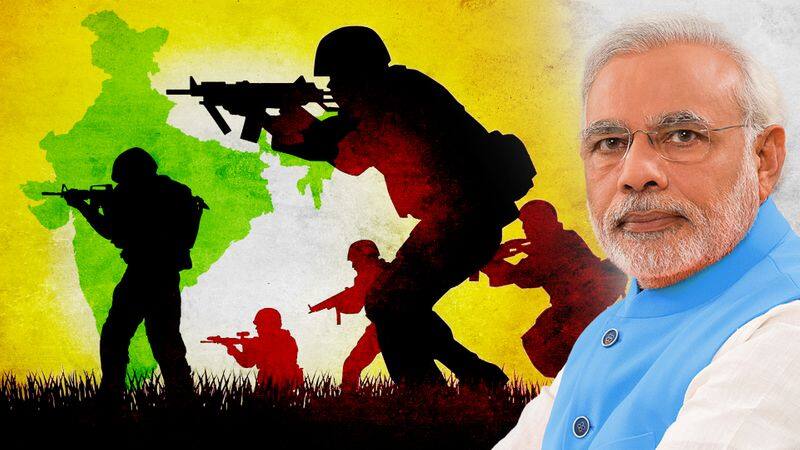When it comes to the internal security of the nation, the government's approach has been largely applauded. One of the best achievements for the Narendra Modi-led government is shrinking of Left Wing Extremism (LWE) network
New Delhi: The NDA-led Union government may have faced criticism over various issues, but when it comes to the internal security of the nation, the government's approach has been largely applauded. How firmly the government has managed to stop terrorists and maoists can be judged by the fact that the country has not seen any major terror incidents recently, especially in metropolitan cities like Delhi and Mumbai. Also, the maoists' network is also shrinking.
In Jammu and Kashmir, concerted anti-militancy operations have resulted in the elimination of a large number of terrorists, while the local body elections were conducted smoothly.
Moaist footfall shrinks
One of the best achievements for the Narendra Modi-led government is shrinking of Left Wing Extremism (LWE) network. According to the government, in 2013, there were a total of 76 maoist violence-affected districts, which has been reduced to 58. Not only this, incidents of violence have seen a sharp decline and now just 30 of these districts account for 90% of the LWE violence in the country. The LWE network is shrinking but some new districts have also emerged as new playgrounds for naxals as eight new districts have been added to the list.
Jammu and Kashmir, rise in counter-terrorism operations
In India’s most tense state of Jammu and Kashmir, amidst increased incidents of stone pelting and rise in counter-terrorism operations in the Kashmir Valley, the Union government successfully conducted the local elections. Also, the government extended ceasefire during the Ramazan. The Valley has also witnessed a rise in anti-militancy operations, resulting in significant gains. Almost 238 terrorists were killed in as many as 587 incidents, while 86 security forces personnel were martyred and 37 civilians killed this year as on December 2, 2018.
The government, for securing Indian borders, introduced smart border fencing projects built under the Comprehensive Integrated Border Management System (CIBMS) programme. The two projects, each covering a 5.5 km border stretch along the international border, have got a hi-tech surveillance system that creates an invisible electronic barrier on land, water and even in air and underground and helps the BSF detect and foil infiltration bids in difficult terrains.
Northeast: AFPSA lifted partially and NRC rolled out
The NDA government in 2018 rolled out a draft of the National Registry of Citizens (NRC), which deals with illegal immigrants. Almost 40 lakhs names were removed, making them illegal immigrants. The government, which was targeted by opposition parties, assured that all valid citizens will get a chance to represent their cases at multiple levels before labelling them as official illegal immigrants.
Another major development for the Northeast states was the lifting of Armed Forces (Special Powers) Act (AFSPA). AFSPA has been lifted from all areas of Meghalaya on March 31. In Arunachal Pradesh, areas under AFSPA have been reduced from 16 areas bordering Assam to eight police stations, besides Tirap, Changlang and Longding districts.
All good efforts by the government went down the drain when the top two bureaucrats of India’s most premier investigating agency Central Bureau of Investigation (CBI), started an ugly and embarrassing fight with each other by levelling serious corruption allegations.
CBI vs CBI controversy
This is the biggest and most denting controversy which has damaged India’s most premier investigating agency— the Central Bureau of Investigation (CBI)’s image. Two top officers, director Alok Verma, and special director Rakesh Asthana alleged corruption allegations against each other. Verma also filed a case where Asthana was named in the FIR as an accused, interestingly, after meeting Prime Minister Narendra Modi. On the other hand, Asthana also filed a complaint against Verma alleging corruption, to the Cabinet secretary. The Union government, who was watching the open war between the two bureaucrats, sent both the officers on leave and transferred almost a dozen others.
But the matter didn’t stop there. Verma approached the apex court while Asthana approached the high court for quashing the FIR. Other officers who were transferred also approached the court’s transfer order. The matter is still pending in court and the apex court is likely to pronounce its judgment in January. More importantly, Verma is retiring on January 31.
Issues which require more work
The Ministry of Home Affairs struggled with issues like mob lynching, vandalism and rumour-mongering over the net on the internal security front. States like Uttar Pradesh and Rajasthan saw maximum crimes related to mob lynching and vandalism. However, the government claims to have set up a High Level Committee (HLC) chaired by the Union Home secretary to deliberate on incidents of mob lynching. The government further decided to constitute a group of ministers headed by the Union Home minister to consider the recommendations of the HLC.
Last Updated Dec 31, 2018, 5:16 PM IST











![Salman Khan sets stage on fire for Anant Ambani, Radhika Merchant pre-wedding festivities [WATCH] ATG](https://static-ai.asianetnews.com/images/01hr1hh8y86gvb4kbqgnyhc0w0/whatsapp-image-2024-03-03-at-12-24-37-pm_100x60xt.jpg)
![Pregnant Deepika Padukone dances with Ranveer Singh at Anant Ambani, Radhika Merchant pre-wedding bash [WATCH] ATG](https://static-ai.asianetnews.com/images/01hr1ffyd3nzqzgm6ba0k87vr8/whatsapp-image-2024-03-03-at-11-45-35-am_100x60xt.jpg)



